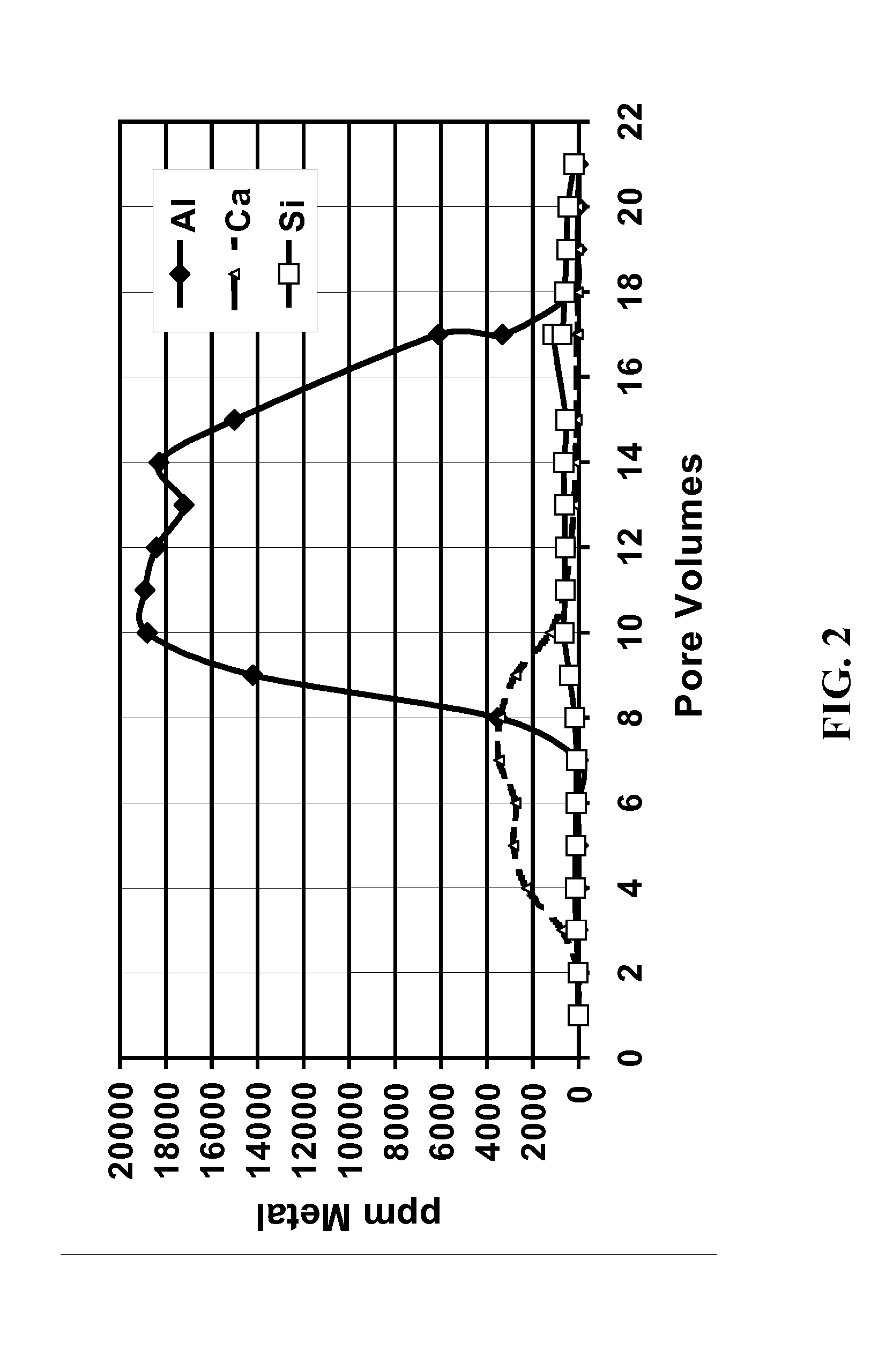Solid Sandstone Dissolver
a technology of solid sandstone and dissolver, which is applied in the direction of fluid removal, wellbore/well accessories, chemistry apparatus and processes, etc., can solve the problems of affecting the stability or effectiveness of other components, acid corrosion creates iron compounds such as iron chlorides, and strong acids are corroded to such materials, so as to slow down the release of hydrogen fluoride and slow down the hydrolysis
- Summary
- Abstract
- Description
- Claims
- Application Information
AI Technical Summary
Problems solved by technology
Method used
Image
Examples
example 1
[0046] To simulate the effects of acid fracturing with a slurry of polylactic acid and ammonium bifluoride, a fluid containing 10% lactic acid (the hydrolysis / dissolution product of polylactic acid) and 4% ammonium bifluoride was injected into a 2.5 cm by 15.2 cm Berea sandstone core at 350° F. (177° C.) at a flow rate of 2.5 ml / min with a confining pressure of 6.9 MPa and a back pressure of 10.3 MPa. FIG. 1 shows a plot of different metal concentrations measured in the effluent fluid as a function of the total fluid volume pumped during a single core flow experiment. The fluid was collected at the outlet of the core flow equipment and was analyzed by ICP. The steady increase in Si concentration is a clear indication that, in combination with a fluoride-containing fluid, the polylactic acid hydrolysis product dissolved a significant amount of silicates from the sandstone. For comparison, FIG. 2 shows the results when a fluid that was 10% acetic acid in 9 / 1 mud acid was pumped throug...
example 2
[0047]FIGS. 3 and 4 show a core flow experiment in which a split sandstone core was used and the affect of inert masking material was simulated. FIG. 3A shows the core with masking material in place, and FIG. 3B shows the core after etching. The 2.5 cm×15 cm inch core was cut in half along the core length; one half is shown as [12]. Teflon fibers [8] (about 0.08 cm×about 15 cm) were placed between the two pieces as shown in FIG. 3A. The pieces were then reassembled and loaded into a core holder, and a confining pressure of 13.8 MPa was applied. FIG. 4 shows the permeability when several fluids were injected into the gap between the two sandstone pieces in the core holder. A 5% ammonium fluoride solution was injected (triangles before about 7 min.) at a flow rate of 5 cc / min, then 12 / 6 mud acid at the same flow rate 9 squares), and then 5% ammonium fluoride again at the same flow rate (triangles after about 17.5 min.). The permeability was clearly higher after the treatment of this s...
example 3
[0048] A typical acid fracturing job of the invention is pumped with a pad to initiate the fracture and to maintain the fracture width until the solids reach and fill the fracture. Optionally, the treating fluid with solids may be used to initiate and propagate the fracture. Once the fracture is initiated, a mixture of, for example, solid polylactic acid (PLA) particles and solid HF source particles is pumped to fill the volume of the fracture completely. Optionally, the solids content is ramped up to achieve the maximum amount of solids placement with a minimum probability of bridging. Typical loading for the solids is, for example, about 0.5 kg solids per L of fluid. After the fracture is created and the solids are placed, the well is optionally shut in to allow more complete hydrolysis of the solid acid precursor to occur. When the PLA hydrolyzes, lactic acid is formed. The lactic acid then initiates the release of hydrogen fluoride and the hydrogen fluoride concentration increas...
PUM
 Login to View More
Login to View More Abstract
Description
Claims
Application Information
 Login to View More
Login to View More - R&D
- Intellectual Property
- Life Sciences
- Materials
- Tech Scout
- Unparalleled Data Quality
- Higher Quality Content
- 60% Fewer Hallucinations
Browse by: Latest US Patents, China's latest patents, Technical Efficacy Thesaurus, Application Domain, Technology Topic, Popular Technical Reports.
© 2025 PatSnap. All rights reserved.Legal|Privacy policy|Modern Slavery Act Transparency Statement|Sitemap|About US| Contact US: help@patsnap.com



